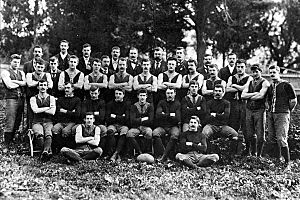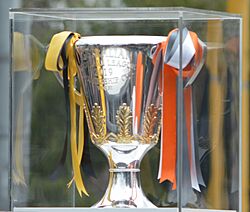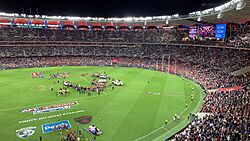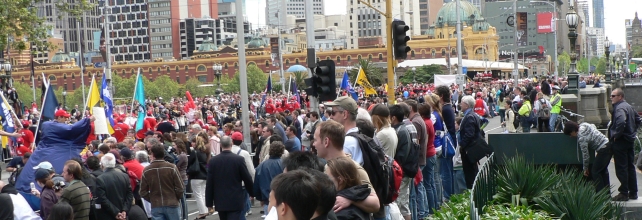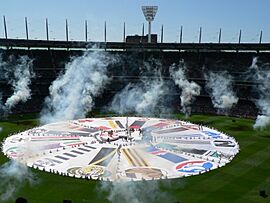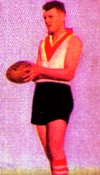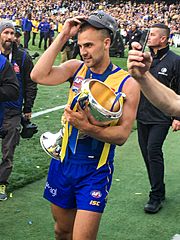AFL Grand Final facts for kids
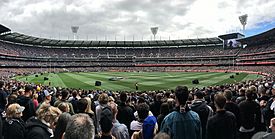
Panorama of the Melbourne Cricket Ground prior to the 2018 AFL Grand Final
|
|
| Other names | VFL Grand Final (historical), "the Granny", "The GF", "The Big Dance", "The Big Day", and "The One Day in September" |
|---|---|
| Sport | Australian rules football |
| First meeting | 24 September 1898 |
| Latest meeting | 28 September 2024 |
| Next meeting | 27 September 2025 |
| Broadcasters | Seven Network |
| Stadiums | Melbourne Cricket Ground (all but 11 occasions) |
| Statistics | |
| Meetings total | 129 |
| Most wins | Carlton, Collingwood (16) |
The AFL Grand Final is a big Australian rules football game. It decides which team is the champion of the Australian Football League (AFL) season. Before 1990, it was called the VFL Grand Final. This was because the league was known as the Victorian Football League. The name changed when the sport grew across Australia.
This exciting game happens at the end of the finals series. It has been played every year since 1898, except for 1924. The Grand Final is usually held on the last Saturday afternoon in September. Its traditional home is the Melbourne Cricket Ground (MCG). As the most important game of the AFL season, it draws huge crowds. More than 100,000 people often watch it live. Millions more tune in on television.
The team that wins the grand final gets the AFL's premiership cup and a special flag. Players on the winning team receive a gold premiership medal. The best player in the game wins the Norm Smith Medal.
By the end of 2024, 129 Grand Finals had been played. This includes three games that were drawn and then replayed. The Carlton Football Club and Collingwood Football Club have each won 16 Grand Finals. This is the most wins for any club. The Essendon Football Club has also won 16 premierships, but only 14 of these were won in Grand Finals. Collingwood has played in the most Grand Finals, with 45 appearances. They also won the most Grand Finals in a row, with four straight wins from 1927 to 1930. Every current AFL club has played in at least one Grand Final. The only exception is the Gold Coast club, which joined the league in 2011.
Contents
History of the Grand Final
How the Game Started (1897–1915)
The Victorian Football League (VFL) began in 1897. Eight clubs left the Victorian Football Association (VFA) to form this new league. The VFL introduced a new system of finals after the regular season. This meant the champion team was decided in the very last game. This made the end of the season much more exciting for fans. The VFA used to just award the premiership based on who had the best win-loss record. The new league also shared money from finals games among all teams. This helped the smaller clubs.
The first Grand Final happened on September 24, 1898. It was played between Essendon and Fitzroy. The game took place at the St Kilda Cricket Ground. Fitzroy won the first Grand Final with a score of 5.8 (38) to Essendon's 3.5 (23). About 16,538 people watched the game.
Until 1930, the VFL often used a short finals system. This usually ended with a game called the 'final'. If the team that finished first in the regular season (the minor premiers) did not win this 'final', they could challenge the winner to another game. This challenge match was called the Grand Final. Now, all 'final' matches that decided the premiership are considered Grand Finals.
The 1899 VFL grand final was one of these early games. Fitzroy won it. If South Melbourne had won, they would have had to beat Fitzroy again in a challenge match.
In 1902, the Grand Final was first played at the Melbourne Cricket Ground (MCG). Collingwood beat Essendon 9.6 (60) to 3.9 (27). A record crowd of 35,000 people watched. By 1908, all finals games were played at the MCG. New attendance records were set in 1908 (50,261), 1912 (54,463), and 1913 (59,479). During this time, Carlton became the first club to win three premierships in a row.
Grand Finals Between the Wars (1916–1945)
Football and Grand Finals continued during World War I. However, fewer people attended the games. Some people thought it was wrong to play sports during wartime. But many soldiers supported the games. Returned soldiers even got free entry to the 1918 Grand Final.
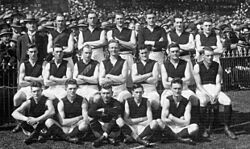
In the 1920s, the VFL faced problems with the challenge final system. Sometimes, the semi-final games had bigger crowds than the Grand Final itself. In 1924, for the second and last time, no official Grand Final was played. This was because the team that finished first, Essendon, also won the round-robin finals. This new system only lasted one year. A new record crowd of 64,288 watched Geelong win its first Grand Final in 1925. Between 1927 and 1930, Collingwood became the only club to win four premierships in a row.
In 1931, the Page–McIntyre Final Four system was introduced. This system guaranteed a Grand Final every year. It also meant that one team would have a week off before the Grand Final. The other team would play a preliminary final the week before. Often, the Grand Final was a rematch of the second semi-final played two weeks earlier.
New crowd records were set in the 1930s. The MCG's new Southern Stand was built in 1937. That year, the Geelong–Collingwood Grand Final attracted 88,540 people. The next year, 96,486 watched Collingwood play Carlton. Melbourne was very strong before World War II, winning Grand Finals in 1939, 1940, and 1941.
Football helped people during World War II. It also helped raise money for the war effort. The Australian government used some VFL grounds, including the MCG. So, Grand Finals were played at Carlton's Princes Park in 1942, 1943, and 1945. The 1944 game was at the St Kilda Cricket Ground. The 1945 Grand Final saw 62,986 people pack into Princes Park. This game was played just weeks after the war ended.
After the War (1946–1990)
The MCG was returned by the government in August 1946. People were very excited for the Grand Finals. Attendances quickly returned to 1930s levels. In 1948, Essendon and Melbourne played the first drawn Grand Final. A full replay was played the next week, which Melbourne won. It was common to see thousands of fans sitting between the fence and the boundary line. This sometimes led to injuries when players ran into them. Fans would line up outside the stadium from Friday to get the best spots on Saturday morning.
The MCG was upgraded for the 1956 Olympic Games. The 1956 Grand Final was like a practice run for the Olympics opening ceremony. The official capacity was 120,000, but 115,802 people attended. Some fans sat in dangerous spots, like on grandstand fences or even roofs. Outside the ground, thousands forced their way in. At least 20,000 people were turned away. To stop these problems, the VFL started selling tickets in advance from 1957.
Melbourne was very strong in the 1950s. They played in a record seven Grand Finals in a row from 1954 to 1960. They won five premierships, including three in a row from 1955 to 1957. The modern premiership cup was introduced in 1959. This made the post-game celebration more formal. Delayed TV broadcasts of the game started in 1961. The grandstands were expanded again in 1968. A record crowd of 121,696 watched the famous 1970 game. Carlton came back from 44 points down at half-time to beat Collingwood. Live TV broadcasts into Victoria began in 1977. That year saw the second drawn Grand Final between North Melbourne and Collingwood. The Norm Smith Medal, for the best player in the game, started in 1979.
In the 1980s, the VFL tried to move the Grand Final to its own ground, VFL Park. They wanted a better business deal. But the state government stopped the move, and the game stayed at the MCG. The 1980s saw Hawthorn dominate. They played in seven Grand Finals in a row from 1983 to 1989, winning four. The 1989 Grand Final was a high-scoring and very physical game. Hawthorn beat Geelong by six points. It is considered one of the greatest games ever. By 1990, Collingwood had lost eight Grand Finals in a row since their 1958 win. This was known as the "Colliwobbles". This streak ended when they beat Essendon in the 1990 Grand Final.
The National Era (1991–Present)
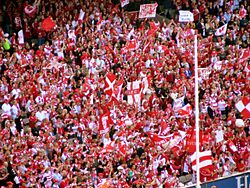
The Victorian Football League (VFL) grew to include teams from other states in the 1980s. It was renamed the Australian Football League (AFL) in 1990. Perth-based West Coast, which joined in 1987, was the first non-Victorian club to play in and win a Grand Final. They played in 1991 and won in 1992. Between 1992 and 2006, non-Victorian clubs won ten of fifteen Grand Finals. The Brisbane Lions had great success, winning three premierships in a row from 2001 to 2003.
Since 1994, new finals systems mean both Grand Final teams must win a preliminary final the week before. This ended the tradition of one team having a week off. The third and final drawn Grand Final happened in 2010 between Collingwood and St Kilda. Collingwood won the replay. Now, extra time is used to decide drawn Grand Finals. However, it has not been needed yet. Hawthorn was very strong in the early 2010s, winning three Grand Finals in a row from 2013 to 2015.
The COVID-19 pandemic changed the Grand Final schedule in 2020 and 2021. Because of virus outbreaks in Melbourne, large gatherings were not allowed in Victoria. In 2020, most clubs moved to Queensland for the season. So, the Grand Final was played at the Gabba in Brisbane. This was the first time it was played outside Victoria. It was also played at night, not in the afternoon. The next season, it was played at Optus Stadium in Perth during twilight.
Prizes for Winning
Winning the premiership is a huge honor. The winning club also receives four prizes: the premiership cup, the premiership flag, the E. L. Wilson Shield, and A$1.2 million in prize money.
The premiership flag is a very important symbol. It is a large, triangular pennant in the league's colors. It has the league logo, the word 'premiers', and the year of the win. The flag is not given out after the game. Instead, it is traditionally unfurled (unrolled) from the flagpole at the winning team's first home game the next season. This tradition has been around since the very first VFL premiership in 1897. Even though the cup is more valuable, the flag is still very symbolic. "The flag" is often used to mean the premiership itself in Australian rules football.
The most famous award for fans is the AFL premiership cup. It is given to the captain and coach of the winning team after the game. Before the Grand Final, the captains of both teams traditionally hold one side of the cup for photos. The cup is silver (except for the 1996 cup, which was gold for the league's 100th season). It is decorated with ribbons in the winning team's colors. A new cup is made every year. The cup was first introduced in 1959. Since 1966, the winning team has done a lap of honor with the cup. Since 2004, a past legend from the winning club usually presents the cup.
The winning club's name is also put on the E. L. Wilson Shield. This shield is kept at AFL House. It was named after a long-serving VFL secretary, Edwin Lionel Wilson. It was started in 1929.
As of 2019, the winning team also gets $1.2 million in prize money. The team that comes second gets $660,000.
Premiership Medals
Every player on the winning team who plays in the Grand Final gets a premiership medal. For most of the league's history, clubs gave these medals to their players. But since live TV broadcasts started in 1977, the league itself gives out the medals after the game. Since 2002, children from the Auskick junior football program present the medals.
The league-awarded medal is only for players who play in the winning Grand Final team. Players who do not play in the Grand Final do not get a medal, even if they helped the team during the season. This has caused some debate.
From 1977 to 1981, medals were also given to the players on the losing team. This stopped after 1981. It is often said this was because Collingwood's Peter Moore threw his medal on the ground after losing his fourth Grand Final.
Individual Player Awards
The Norm Smith Medal is given to the player judged best on the field in the Grand Final. A group of experts decides who wins. The award is named after Norm Smith, a great player and coach for Melbourne. It was first given out in 1979. It is a very important individual award.
The coach of the winning team receives the Jock McHale Medal. It is named after Collingwood coach Jock McHale, who won a record eight premierships. This medal was first given in 2001. It was also given to all premiership-winning coaches from 1950 onwards.
The captain or co-captains of the winning team receive the Ron Barassi Medal. This medal is named after Ron Barassi Jr, who won ten premierships as a player and coach. It was first awarded in 2024.
The player who kicks the most goals in the game gets the Jack Collins Medal.
Where the Grand Final is Played
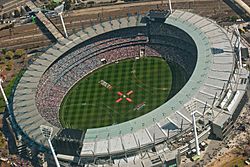
The first four Grand Finals were played at different neutral grounds. These were chosen by the league a week before the game. They included the St Kilda Cricket Ground (1898 and 1899), the East Melbourne Cricket Ground (1900), and the South Melbourne Cricket Ground (1901).
Since 1902, the Grand Final has almost always been played at the Melbourne Cricket Ground (MCG). This is thanks to a deal with the Melbourne Cricket Club (MCC). Under the current agreement, the MCG is set to host the game every year until 2059.
Only seven Grand Finals since 1902 have been played at other grounds:
- From 1942 to 1945, the MCG was used by the military during World War II. These Grand Finals were played at Princes Park (1942, 1943, and 1945) and the St Kilda Cricket Ground (1944).
- In 1991, the MCG's capacity was cut in half due to construction. The Grand Final was played at Waverley Park.
- During the COVID-19 pandemic in 2020 and 2021, travel and crowds were restricted in Victoria. These Grand Finals were played at The Gabba in Brisbane (2020) and Optus Stadium in Perth (2021).
The Grand Final usually sells out every year. It is often one of the most attended sports championship events in the world. The MCG can hold 100,024 people. Tickets are given to different groups, like AFL members, club members, and sponsors.
History of the Venue
The MCG has been the main venue for the Grand Final for a long time. The VFL did not always like relying on the MCG. The ground's trust set ticket prices, and the MCC kept a large part of the money. MCC members also got free entry. In the 1960s, the VFL built its own ground, VFL Park. It could hold 75,000 people. The league wanted to move the Grand Final there from 1984. They planned to make it bigger, but the government stopped them. The game stayed at the MCG.
Now that the league has teams from other states, some people say the MCG deal is unfair. Non-Victorian clubs play fewer games at the MCG. They also have to travel to Melbourne for the Grand Final.
When the Grand Final is Played
The Grand Final is usually played on the afternoon of the last Saturday in September. It is often called the "One day in September," which is also the name of a famous football song. Since 1987, it has been during the spring school holidays in Victoria. Since 2015, the Friday before the Grand Final has been a public holiday in Victoria.
Sometimes, the game is in early October. Before 1991, if a finals game was a draw, it would be replayed. This would push the Grand Final into October. The earliest Grand Final was on September 2, 1916, in a shorter war season. The 2000 Grand Final was also early to avoid the Sydney Olympics. The latest Grand Final was on October 24, 2020. This was due to the COVID-19 pandemic.
The Grand Final has always been played in the traditional Saturday afternoon slot, usually at 2:30 PM AEST. This is out of respect for tradition. Even though playing at night could bring more money from TV deals, the afternoon slot has stayed. Only the two Grand Finals played outside Victoria were at night.
Drawn Games
Until the 2015 season, if a Grand Final was a draw, it would be replayed the next Saturday. This happened three times: in 1948, 1977, and 2010.
In 2016, rules changed to include extra time for drawn Grand Finals. This means the game will always be decided on the scheduled day. If a game is drawn, teams play two extra time periods. If it is still tied, they play more extra time until a winner is found. As of 2024, extra time has not been needed to decide a Grand Final.
Grand Final Traditions
Grand Final Parade
Since 1977, a Grand Final parade has been held on the Friday before the game. Players from both teams ride in open-top vehicles. From 2015 to 2019, the parade started at the Old Treasury Building and ended near the MCG. The parades in 2020 and 2021 did not happen due to the COVID-19 pandemic. In 2022, part of the parade saw teams travel on boats down the Yarra River.
When two Victorian teams play and the weather is good, the parade can attract over 100,000 fans. In 2015, a record 150,000 people attended the parade.
Grand Final Breakfast
The North Melbourne Grand Final Breakfast has been held every year since 1967. It is a special breakfast event with famous speakers and guests. These guests include prime ministers, state leaders, and football stars. It is the most well-known event linked to the Grand Final. It became popular in the 1970s when it was first shown on TV. Today, the breakfast is broadcast live on Fox Footy.
On-Field Entertainment
Since the game was first shown live on TV, many big Australian and international music stars have performed. They play before the game or at half-time. Sometimes, the entertainment has been criticized. Two performances, Angry Anderson in 1991 and Meat Loaf in 2011, are often remembered for being poor. Since 2012, the main performer also plays a concert after the game. This concert is free for everyone.
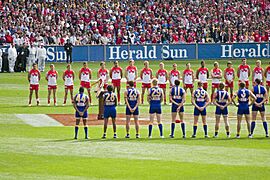
The pre-game entertainment often includes traditional football songs. These include "Up There Cazaly" and "One Day in September". There is also a motorcade where players who have retired since the last Grand Final are honored.
Before the main game, other matches are played on the field. Since 2008, this has been a game for under-16s or under-17s players. It is now called the AFL Futures match.
After the teams enter the field, they line up for a team photo. The national anthem is sung live when the teams and umpires are lined up.
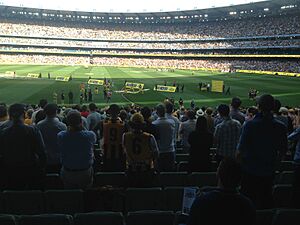
As part of the entertainment, a sprint race called the AFL Grand Final Sprint is held. Players not in the game compete. This race started in 1979 and was brought back in 2002.
Post-Match Customs
From the 1940s to the 1980s, players sometimes swapped jerseys after the game. This was a custom from soccer. This meant that in photos of St Kilda celebrating their 1966 premiership, their captain was wearing a Collingwood jersey. The VFL banned captains from swapping jerseys after 1966. The custom eventually stopped.
A premiership poster is made and sold after the game by the Herald Sun newspaper. It usually shows a cartoon of the winning club's mascot. These posters are very popular with fans and collectors. They sell over 100,000 copies each year.
Famous Grand Final Moments
Many memorable moments have happened in Grand Final history:
- 1903, Collingwood 4.7 (31) d. Fitzroy 3.11 (29) — In the final moments, Fitzroy captain Gerald Brosnan had a shot to win the game. His kick just missed, and the final siren sounded.
- 1910, Collingwood 9.7 (61) d. Carlton 6.11 (47) — The last quarter had a huge fight. The umpire, Jack Elder, stopped it by bouncing the ball. Four players were suspended for a year or more. This event started the long-standing Carlton–Collingwood rivalry.
- 1918, South Melbourne 9.8 (62) d. Collingwood 7.15 (57) — In the last seconds, South Melbourne's Chris Laird kicked the winning goal from the ground.
- 1927, Collingwood 2.13 (25) d. Richmond 1.7 (13) — Heavy rain made the game very difficult. Only 38 points were scored. It was the lowest-scoring VFL/AFL game of the 20th century.
- 1935, Collingwood 11.12 (78) d. South Melbourne 7.16 (58) — Bob Pratt, South Melbourne's star player, missed the game. He was hit by a truck two days before. South Melbourne lost without him.

- 1945, Carlton 15.13 (103) d. South Melbourne 10.15 (75) — This game was known as the Bloodbath due to constant fighting. Ten players were reported and suspended for a total of 73 weeks.
- 1947, Carlton 13.8 (86) d. Essendon 11.19 (85) — In the final minute, Fred Stafford (Carlton) kicked the winning goal for Carlton.
- 1948, Essendon 7.27 (69) drew Melbourne 10.9 (69) — Essendon missed many shots at goal, leading to a draw. Norm Smith (Melbourne) had two chances to win in the last minute but missed. Melbourne won the replay.
- 1964, Melbourne 8.16 (64) d. Collingwood 8.12 (60) — With three minutes left, Neil Crompton (Melbourne) kicked the winning goal. It was his only goal in his last five seasons.
- 1966, St Kilda 10.14 (74) d. Collingwood 10.13 (73) — With scores tied and 90 seconds left, 18-year-old Barry Breen (St Kilda) kicked the winning point. This secured St Kilda's first and only premiership.
- 1970, Carlton 17.9 (111) d. Collingwood 14.17 (101) — Carlton came back from 44 points down at half-time to win. This was a huge comeback. The game had a record attendance of 121,696. It also featured an amazing mark by Alex Jesaulenko (Carlton).
- 1972, Carlton 28.9 (177) d. Richmond 22.18 (150) — With a total of 327 points, this was the highest-scoring VFL/AFL game at the time.
- 1977, North Melbourne 9.22 (76) drew Collingwood 10.16 (76) — North Melbourne came back in the last quarter to tie the game. Ross Dunne (Collingwood) kicked the tying goal with 40 seconds left.
- 1977 replay, North Melbourne 21.25 (151) d. Collingwood 19.10 (124) — Phil Manassa (Collingwood) ran the length of the field and kicked a famous goal. Even though Collingwood lost, the goal is still remembered.
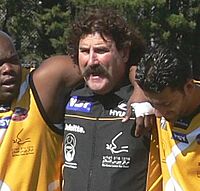
- 1979, Carlton 11.16 (82) d. Collingwood 11.11 (77) — Wayne Harmes (Carlton) famously punched the ball back from the boundary line. His teammate Ken Sheldon gathered it and kicked the winning goal.
- 1989, Hawthorn 21.18 (144) d. Geelong 21.12 (138) — This game was very rough. Many players were injured. Dermott Brereton (Hawthorn) was knocked out at the start but played on. Robert DiPierdomenico (Hawthorn) played with a serious lung injury. Hawthorn held on to win despite many injuries.
- 2005, Sydney 8.10 (58) d. West Coast 7.12 (54) — With seconds left, Sydney defender Leo Barry took a clean mark in a crowded goal square to secure the win.
- 2009, Geelong 12.8 (80) d. St Kilda 9.14 (68) — With less than four minutes left, Matthew Scarlett (Geelong) cleverly kicked the ball to Gary Ablett Jr.. This led to a goal by Paul Chapman, giving Geelong the lead.
- 2010, Collingwood 9.14 (68) drew St Kilda 10.8 (68) — A very close game that ended in a draw. A tricky bounce of the ball prevented St Kilda from winning. Collingwood won the replay.
- 2018, West Coast 11.13 (79) d. Collingwood 11.8 (74) — West Coast came back from 29 points down. With less than three minutes left, Dom Sheed (West Coast) kicked the winning goal from a difficult angle.
Watching the Grand Final on TV
The Grand Final is one of the most-watched TV events in Australia each year. Since 2001, it has often been the highest-rated program of the year. The worldwide audience has grown a lot, with broadcasts in 72 countries. An estimated 30 million people watch it around the world.
When TV first started in Australia in 1956, the VFL was worried that showing the Grand Final live would stop people from going to the game. The Grand Final was first shown on TV in 1961, but as a replay an hour after the game finished. Live TV broadcasts into Victoria started in 1977. The game has been broadcast live in color since then, and in high definition since 2015.
The Grand Final is protected by special laws in Australia. These laws make sure it stays on free-to-air television. Some old footage of Grand Finals from before 1961 still exists. Video from the 1909 Grand Final is the oldest known Australian football footage.
The record for metropolitan viewers was set in 2005. That year, Sydney beat West Coast. The total TV record was set in 2024 for the Brisbane versus Sydney match.
International Broadcasts
The AFL Grand Final is shown in many countries. Grand Final parties are held all over the world.
- Papua New Guinea — EM TV, Australia Plus (live)
- New Zealand — Sky Sport (live) and TVNZ (live)
- Asia-Pacific — ABC Australia (live)
- Indian subcontinent — ABC Australia (live)
- China — GZTV (live)
- Middle East — Australia Plus and Orbit Showtime Network (live)
- Israel — Fox Sports Israel (live)
- North America
- United States — Fox Sports.
- Canada — TSN (live).
- United Kingdom and Ireland — TNT Sports (live)
- ALL of Europe — Eurosport 2 (live/delayed coverage to be confirmed)
- Africa — Kwesé Sports Orbit Showtime Network (live)
- Latin America and Caribbean — ESPN International (to be confirmed)
- Russia — Viasat (live)
See also
- Grand final
- List of Australian Football League premiers
- List of VFL/AFL premiership captains and coaches
- List of VFL/AFL Grand Final records
- AFL Women's Grand Final
- NRL Grand Final


